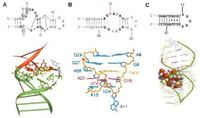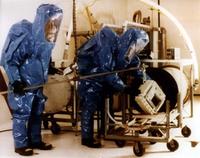-
Improving safety in the presence of chemical hazards
A new kind of sensor could warn emergency workers when carbon filters in the respirators they wear to avoid inhaling toxic fumes have become dangerously saturated; first responders protect themselves from such vapors, whose composition is often unknown, by breathing through a canister filled with activated charcoal — a gas mask; airborne toxins stick to the carbon in the filter, trapping the dangerous materials, and as the filters become saturated, chemicals will begin to pass through; the respirator can then do more harm than good by providing an illusion of safety
-
-
Magnetic "nanobeads" detect chemical and biological agents
Researchers at Oregon State University have found a way to use magnetic “nanobeads” to help detect chemical and biological agents, with possible applications in everything from bioterrorism to medical diagnostics, environmental monitoring, or even water and food safety; rapid detection of chemical toxins used in bioterrorism would be possible, including such concerns as anthrax, ricin or smallpox, where immediate, accurate and highly sensitive tests would be needed
-
-
Trees as contamination detectors
Determining the presence and concentration of contaminants has been an invasive, laborious process; now a Missouri University of Science and Technology team has developed a faster, more economical method of determining such contamination at miniscule levels; the Army has funded additional research for explosive residue detection
-
-
OSU chemist developing solution to nerve agent exposure
Scientists are working to develop a new drug that will regenerate a critical enzyme in the human body that “ages” after a person is exposed to deadly chemical warfare agents; the drug will counter the effects of Tabun, VX, VR, Sarin, Soman, Cyclosarin, and Paraoxon, all of which take on a similar molecular structure upon aging
-
-
Universal detector made of DNA building blocks

Aptamers are composed of the building blocks of the genetic material DNA; scientists show that aptamers can be used quantitatively to detect and accurately examine multifaceted substances; a method for detecting such diverse substances as antibiotics, narcotics, and explosives - in effect, a universal detector — has been developed by researchers at the Max Planck Institute for Polymer Research in Mainz
-
-
Biosensor improves pathogen detection in food, water
A nanotechnology-based biosensor being developed by Kansas State University researchers may allow early detection of both cancer cells and pathogens, leading to increased food safety and reduced health risks
-
-
Detecting invisible threats to first responders, soldiers
There are many methods currently being used that can detect chemical and biological agents and explosive compounds, but none allows for the unique fingerprinting of threat agents at trace levels; researchers have overcome this limitation with surface enhanced Raman scattering (SERS) using optically stimulated plasmon oscillations in nanostructured substrates; SERS offers several potential advantages over other spectroscopic techniques because of its measurement speed, high sensitivity, portability, and simple maneuverability
-
-
Army signs deal with ChemImage for explosive detection technology
The U.S. Army’s Space and Missile Defense command recently signed a $17 million contract with ChemImage Corporation to implement its real-time sensor technology to detect explosive threats in the field; ChemImage’s technology would give U.S. troops the ability to identify objects from a distance to determine if they are explosive, chemical, or biological threats; the devices rely on molecular spectroscopy and digital imaging to analyze material
-
-
U.S. urged to update chem-bio defense efforts

A new report highlights one of the major problems in preparing defenses against chemical and biological (CB) agents: “Given the inherent secrecy with which states and other actors will conduct CB agent development, adversary programs could acquire new CB agents years before U.S. defense planners recognize those agents—- And, after the U.S. intelligence community recognizes those CB agents as threats, the United States will probably need many more years to establish a comprehensive defense against them. Such gaps in CB agent defense capabilities pose a potentially serious risk to U.S. military operations”
-
-
Missing vial of VX nerve agent causes Army base lockdown

VX is an amber-colored, odorless, tasteless oily liquid that evaporates very slowly, almost like motor oil; one of the most lethal chemical weapons agents ever synthesized, it can be absorbed through the skin or inhaled as a vapor; VX affects the body’s ability to carry messages through the nerves, causing rapid death by paralysis; the U.S. Army’s Dugway Proving Ground in Utah was locked down over night — with between 1,200 and 1,400 people inside the facility — after a small vial of VX went missing; the missing vial was found at 3 a.m.; the base commander told reporters that the mishap resulted from VX liquid “misplaced into a different container that was improperly marked.”
-
-
Enzyme provides protection against nerve gas
Nerve agents disrupt the chemical messages sent between nerve and muscle cells, causing loss of muscle control, and ultimately leading to death by suffocation; protection against nerve gas attack is a significant component of the defense system of many countries around the world; nerve gases are used by armies and terrorist organizations, and constitute a threat to both the military and civilian populations, but existing drug solutions against them have limited efficiency; a multidisciplinary team of scientists at the Weizmann Institute of Science in Israel, succeeded in developing an enzyme that breaks down nerve agents efficiently before damage to nerves and muscles is caused
-
-
ICx Technologies: comprehensive, layered approach to security
At the recent ASIS exhibition and seminar, Homeland Security Newswire took the time to walk through the ICx Technologies booth and speak to some of their subject matter experts; CommandSpace® & ThreatSense™, solutions which provide a comprehensive, layered approach to perimeter security and chemical, biological, radiological and nuclear security for critical facilities, respectively, were on display
-
-
New detector tests for illegal drugs, superbugs in minutes
A new method of detecting illegal drugs and super bugs will be used in a U.K. government-backed handheld device that analyzes saliva; the testing takes minutes and costs as little as £1.50 per test; it works by measuring the electric charge generated when the substances in the saliva react with an electrode coated with antibodies
-
-
1st Detect in $735,000 contract for chemical detection in the field
Phase II SBIR contract from the Joint Science & Technology Office for Chemical and Biological Defense will allow the company to design and develop a novel sample inlet system intended to improve the sensitivity of mass spectrometers used for chemical detection in the field
-
-
Iraqi army trains in biological, chemical weapons removal
The Iraqi military is training in removing suspected weapons of mass destruction, including biological and chemical weapon; there are no reliable figures for the amount of unexploded ordinance located in Iraq, let alone those that may contain degraded but still dangerous substances, such as sarin nerve gas or mustard gas
-
- All
- Regional
- Water
- Biometrics
- Borders/Immig
- Business
- Cybersecurity
- Detection
- Disasters
- Government
- Infrastructure
- International
- Public health
- Public Safety
- Communication interoperabillity
- Emergency services
- Emergency medical services
- Fire
- First response
- IEDs
- Law Enforcement
- Law Enforcement Technology
- Military technology
- Nonlethal weapons
- Nuclear weapons
- Personal protection equipment
- Police
- Notification /alert systems
- Situational awareness
- Weapons systems
- Sci-Tech
- Sector Reports
- Surveillance
- Transportation
Advertising & Marketing: advertise@newswirepubs.com
Editorial: editor@newswirepubs.com
General: info@newswirepubs.com
2010-2011 © News Wire Publications, LLC News Wire Publications, LLC
220 Old Country Road | Suite 200 | Mineola | New York | 11501
Permissions and Policies
Editorial: editor@newswirepubs.com
General: info@newswirepubs.com
2010-2011 © News Wire Publications, LLC News Wire Publications, LLC
220 Old Country Road | Suite 200 | Mineola | New York | 11501
Permissions and Policies
